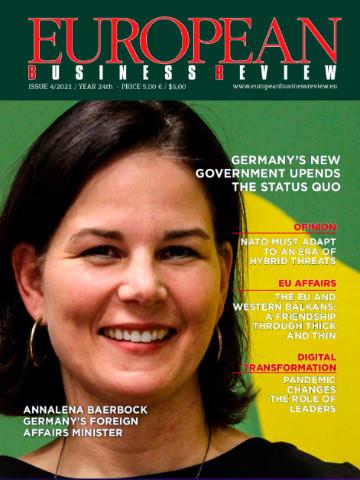Higher education must still go global
Students need global understanding, now more than ever

Over its last three surveys (2001, 2006 and 2011), the American Council for Education found that the percentage of higher education institutions pursuing internationalisation is low. They measured those that include it in their mission statement or strategic plan or have a campus-wide committee or task force to advance efforts in this direction. Doctoral institutions score highest, at around 50 percent, with scores declining at master and bachelor institutions. The percentage of schools that include internationalisation in their mission statement has declined across all types of institutions between 2006 and 2011 after a rise between 2001 and 2006.
by
Gabriel Hawawini*
Despite recent signs of a retreat from globalisation in the United States and Britain, there has not been a broad-based pullback globally. Many countries are keen to stress that they remain “open for business” and China has even shown signs of picking up the baton as the world leader in free trade. In Asia, signatories of the Trans-Pacific Partnership (TPP) have recently agreed to pursue the trade deal even without the United States.
Given these facts and the increasing interconnectedness of business and society, university and business school students still have a thirst for global understanding and exposure.
Students and organisations are acutely aware of two phenomena. The first one is that global companies still seek both academic achievers and globally experienced managers. We know that MBA and university students who have lived overseas have better problem-solving skills. They are also more trusting of others. Recently, cross-cultural relationships and even international romances have been shown to enhance creative performance.
The second phenomenon is the shifting balance of power. Over the second half of the 20th century, a brain drain took place from poor countries to developed ones. Now that infrastructure and living standards have started to improve in developing countries, talent is moving in the opposite direction. It is no longer a given that the world’s best and brightest students will flock to the west. The brain drain is becoming “brain circulation”.
This is reflected in the fact that two thirds of U.S. MBA programmes have received fewer international applications this year than last year, according to the Graduate Management Admission Council (GMAC), which administers business school entrance exams. Canadian and European schools on the other hand, are experiencing an increase. American students are increasingly keen to pursue their higher and post-graduate education abroad.
Internationalisation is still an edge
Over its last three surveys (2001, 2006 and 2011), the American Council for Education found that the percentage of higher education institutions pursuing internationalisation is low. They measured those that include it in their mission statement or strategic plan or have a campus-wide committee or task force to advance efforts in this direction. Doctoral institutions score highest, at around 50 percent, with scores declining at master and bachelor institutions. The percentage of schools that include internationalisation in their mission statement has declined across all types of institutions between 2006 and 2011 after a rise between 2001 and 2006.
Higher education institutions, therefore, should redouble their efforts to offer a truly global learning experience and global knowledge to those who seek it.
Competition also dictates that schools make a concerted effort to go global. Many institutions add international dimensions to their programmes, often as a way to differentiate themselves. Other institutions must respond or run the risk of losing the very best applicants and failing to attract the best faculty.
But as I argue in my recent book, The Internationalization of Higher Education and Business Schools, it is no longer enough for higher education institutions to simply adopt an international outlook. Take The Times Higher Education ranking of universities for example. The “international outlook” pillar of its ranking is based on three significantly inward-looking dimensions. These are the ratio of foreign to international students, the ratio of international to local staff and the proportion of research with an international co-author. On these dimensions, Qatar University, the University of Luxembourg and the University of Hong Kong are leaders in international outlook, but do not rank well when measured along comprehensive lines.
I argue, therefore, that these inward-looking criteria send the wrong signals to institutions looking to be truly international. Creating an international environment, programme or curriculum is a good start, but internationalisation should be an ongoing process of change aiming to integrate the school into the global knowledge economy.
Spread the word
A truly international school should have opportunities for students to study overseas as part of their programme. It should also offer double and joint degree programmes with other schools, as well as set up academic joint ventures so faculty can travel and collaborate with academics in other countries. Some institutions have gone a step beyond this and established a full physical presence abroad, with staff and faculty postings. Business schools have been successful early adopters of the foreign campus approach, growing their presence in the Gulf countries and Asia, where there is strong demand for business education.
As John Sexton, the President of New York University until 2015 argued, global network universities “can influence globalisation positively and, thereby, foster the advancement of humankind in special ways”.
Go global or perish
The apparent retreat of globalisation makes it that much more urgent for universities and business schools to go international. Even with unfettered globalisation taking place until recently, local cultures and customs around the world haven’t necessarily converged. Therefore it is even more imperative for higher education institutions to send their students abroad so they can familiarise themselves with other cultures and learn foreign languages.
Even if one argues that the world is becoming multipolar and knowledge is set to disperse throughout the globe, embedding oneself in its changes and evolutions remains essential. Academic rigour will stay competitive by integrating new teaching methods, programme designs, research methods and learning processes. If a school can generate knowledge in multiple locations around the world and blend it to create new insights, it can be assured of fostering a globally-compatible and creative student body.
In the next article, I will explain in greater detail the key steps educational institutions can take to internationalise, the challenges they are likely to face and how they can overcome them.
*Gabriel Hawawini is a Professor of Finance at INSEAD and the former Dean of INSEAD from 2000 to 2006. Professor Hawawini spearheaded the school’s expansion from Europe into Asia with the opening of the INSEAD Asia Campus in Singapore in 2000.
**First published in knowledge.insead.edu



 By: N. Peter Kramer
By: N. Peter Kramer

